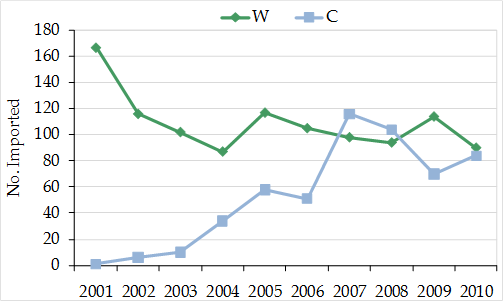2010 Summary for Panthera leo (Annex B) (African Lion)
Criteria met: High volume (globally threatened)
Principal trade term to the EU: trophies, specimens
Principal source: wild-sourced, captive-bred
Top EU importer: trophies: Spain; specimens: France
Top Trading Partner: South Africa, Switzerland
CITES Appendix: II
IUCN Status: Vulnerable

EU-reported imports of Panthera leo trophies and trophy items (bodies, skins and skulls; purposes H, P and T) from the two main sources (‘W’ and ‘C’), 2001-2010.
With the exception of imports for scientific purposes, wild-sourced imports in 2010 comprised 77 trophies, 11 skins, two skulls and two feet (all purpose ‘H’ or ‘P’), equating to approximately 91 individuals in trade. A permit analysis indicates that several trophy items were imported on the same permit as another item, possibly reducing the number of animals involved to 88. Imports of captive-bred parts and derivatives comprised 80 trophies, 28 teeth, three bodies and one skull, equating to approximately 84 individuals in trade. In addition, 34 captive-bred, live animals were imported. Wild-sourced trophy imports decreased between 2009 and 2010, while captive-bred imports increased.
The majority of wild-sourced imports originated in South Africa and Tanzania (42% and 22% respectively), while all the captive-bred trophies and 65% of live, captive-bred imports originated in South Africa.
The SRG formed a positive opinion for Tanzania on 29/02/2008, which was confirmed on 07/06/2012; a negative opinion was formed for all wild specimens from South Africa on 10/11/2011.

